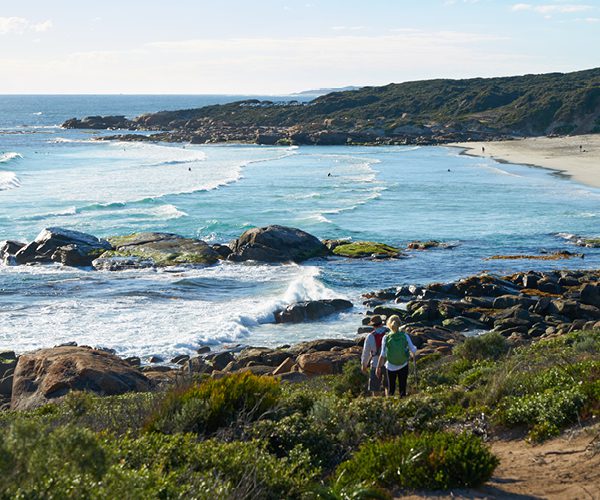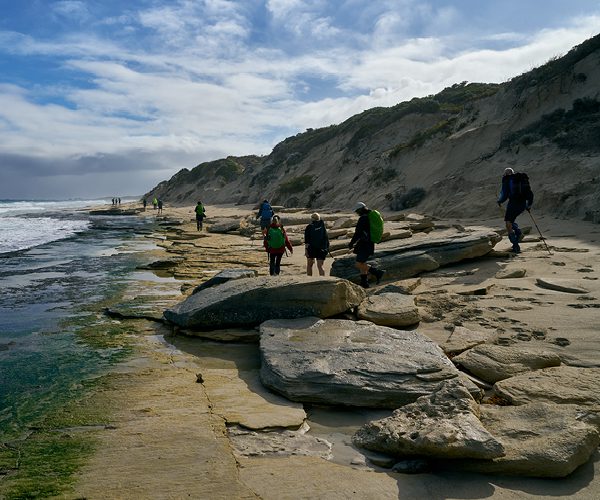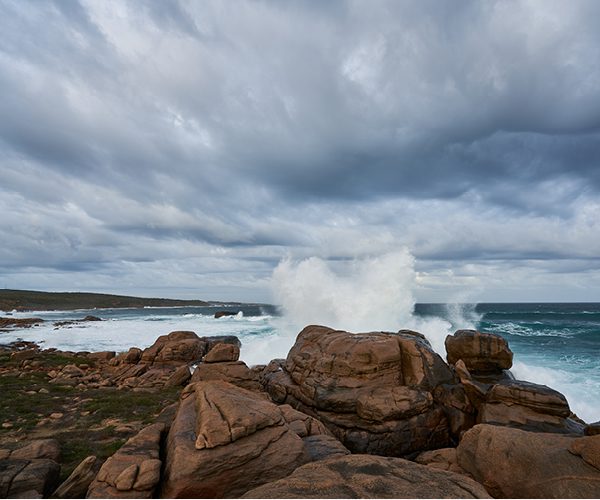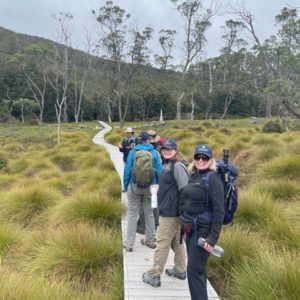Everything you need to know
About Walking the Cape to Cape Track
There’s something about Western Australia. This huge state holds some of the country’s best-kept secrets and this exceptional multi-day walk in the south of the state is one of them.
During the eight-day adventure, you’ll hike close to the rugged coastline, exploring headlands, sea cliffs, beaches and lighthouses, as well as occasionally looping inland to see karri forests, waterfalls and, in the spring, loads of wildflowers. And while there aren’t many actual hills on the route, you’ll certainly be challenged, thanks to some slogs through soft sand and some long days on the trail. You’ll also be covering just over a hundred kilometres in seven days, and that’s no mean feat.
Where does the Cape to Cape go?
After meeting up in Perth early on the first morning, your group will travel to the starting point at Cape Naturaliste, three-and-a-half hours south of the WA capital. Then, for the next seven days, it’s one highlight after another as you hike down the southwest coast.
On the first night you’ll stop at Yallingup, famous for its beaches and caves, then travel along the red clifftops towards Gracetown.
There’s also the chance to visit a historical homestead at Ellensbrook, trek past the mouth of the Margaret River and meander below towering trees in the Boranup Karri Forest. And if you fancy visiting paradise on Earth, you’ll see that too. Hamelin Bay is a sheltered spot with magnificent sands and sparkling turquoise waters – you might want to have your swimsuit in your backpack because, with its shipwrecks and marine life, this is the spot where you’ll want to take a dip.
The end of the track is Cape Leeuwin, the most southwesterly point of the Australian mainland. The peninsula, where the Southern and Indian oceans meet, is marked by a lighthouse constructed in 1895 using local limestone.
What’s the best time of year to trek the Cape to Cape Track?
You can book your Cape to Cape Track challenge between March and May or September to October each year. The weather is usually mild during spring and autumn, with temperatures hovering in the late teens to low 20s. If you and your group want to bask in the natural colours of fresh wildflowers, plan to walk in September or October.
What’s the best time of year to trek the Cape to Cape Track?
The night before you leave, you’ll stay in either a three- or four-star hotel in the Perth CBD. This means your group is all in the one spot, so an early start is easy.
While you’re trekking, you’ll be staying at Beach Break, a collection of three-bedroom houses with kitchen and bathroom facilities. They’re only 500m from the beach, and you’ll also have access to a pool.


What do we need to take?
You’ll need light clothing with full coverage to protect you against the sun, as well as hiking boots that have been thoroughly broken in. You should buy them a couple of months in advance and train in them. Take some long walks (more than 10km) on consecutive days to ensure they don’t start to rub during prolonged use. Also wear your socks beforehand – thin wool socks are the best for preventing blisters and keeping feet cool.
You might also want to bring a pair of hiking sandals or trainers as an alternative, especially for walking along the beach. It is possible to do the entire Cape to Cape wearing a good pair of trainers, but hiking boots offer better ankle support.
Have a good daypack fitted at a hiking store. One with a waist harness will take a significant load off your shoulders and upper back. In your daypack, you’ll need to carry your favourite/preferred snacks, a mini medical kit (Band-Aids, other dressings for blisters, some electrolytes), sunscreen, water, toilet paper (and a sealable plastic bag to carry it out), hand sanitiser, swimmers, spare clothes and shoes and, if you’re bringing one, your camera.
Also pack some wet-weather gear and a lightweight fleece and some other warm gear for cooler evenings and early mornings. You can leave them at your accommodation if the weather forecast suggests you’re not going to need them.
Trekking poles can be useful for taking the pressure off your knees going up and down hills, but make sure you practise with them before starting the walk.
How should we train for the hike?
Start as soon as you’ve made the decision to sign up for the Cape to Cape Track challenge. Talk to your GP if you’ve got any concerns, and consider enlisting the services of a personal trainer.
Many of us don’t have access to long trails close by, so start building strength and endurance in the gym. As the challenge gets closer, however, look for places with similar conditions – beaches with soft sand, hills, bush tracks – where you can do longer walks. As much as possible you’ll want to get off your neighbourhood footpath.
As the starting day approaches, try to do two full-day walks back to back, as well as some walks over 15km (the longest day on the Cape to Cape is 21km, but most days are between 14 and 16km). Put all your gear on – full daypack, clothing, boots, socks – for these walks so you know everything fits properly and doesn’t rub.
If you start to feel any niggles while you’re training – maybe in the knees or ankles – see a physiotherapist who can help with strengthening exercises and show you how to strap them properly.
The harder and longer you train, the more enjoyable the walk will be – not just because you’ll be fitter but also because it will give you the confidence to know you’ll have what it takes to finish the challenge.


Should we extend our stay afterwards?
If you never visited WA before, think about extending your visit and exploring further. Spend a couple of days in the Margaret River region enjoying the surfing, wine and excellent food. There’s plenty to do back in Perth too, including heading to Rottnest Island for a relaxing post-trek break, where you can enjoy the pristine beaches and commune with the quokkas.
Need more info?
You can check out the entire Cape to Cape Track itinerary on our website. Alternatively, if you’ve got any questions about this challenge or would like to sign up for one, you can call us on 1300 905 188.




